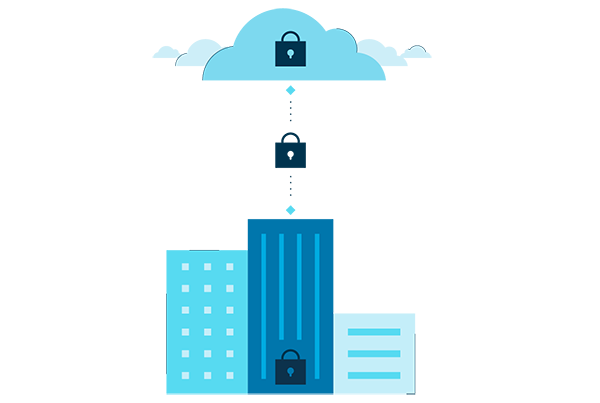Data Backup and Recovery
Did you know that, on average, only 5% of organizations are able to use backups to restore their data in the event of a disaster? This is concerning, given how much organizations rely on their cloud backup of data in the case of a data disaster.
Without proper protection, data disaster events can be incredibly damaging to your business. Having the appropriate data backup solutions and recovery software in place, however, can mean less trouble in the event of an operational failure, ransomware attack, or data corruption.
Here’s your guide to a data disaster and what you need to know about finding and keeping lost data.
What is data backup and recovery?
One of the most common uses for backup and recovery software is to protect organizations against data loss. This an important step in any organization's process because it allows the business to recover from a potential disaster or unforeseen event. Commonly, applications are used to back up important data and restore instantly necessary information if needed.

Data Disasters Happen
In the modern world, the most common method of storing and transferring information is through digital spaces. It’s no longer necessary to keep extensive binders and file folders in large cabinets in the office; now, we can access those files with the touch of a button. But with the loss of physical record-keeping, the business world has encountered a new problem.
What happens when the hardware on which you keep all of your clients’ sensitive, personal information is damaged, lost, or stolen? What if there is a software error that permanently erases significant portions of your business’s essential records?
Planning for Data Disasters
It’s impossible to know for sure that your business will find itself in a data disaster situation. However, accidents and operational failures happen, and it’s also extremely challenging to accurately predict when and where hackers will strike. So, the best thing you can do for your business is to develop a data disaster plan.
Data disaster plans might include things like specialized damage control teams, predetermined information to give to clients in the event of a breach, and efforts to control the data that may be affected. Having this plan in place well ahead of time can reduce the damage that a data breach does to your business, saving you time, money, and stress.
Two of the most significant parts of an exemplary data disaster plan are data backup strategy and recovery.
What Is Data Backup?
Data backup is the process of copying physical or virtual files or databases to a secondary location for preservation in case of equipment failure or other disaster scenario. Backing up data is a crucial component of any disaster recovery (DR) plan. Organizations back up their critical data, capturing and synchronizing a point-in-time snapshot that is then used to return any deleted data to its previous state.
Simply put, data backups guard against data loss. Backups provide a way of restoring deleted files or recovering files that are accidentally overwritten. Notably, backups are usually an organization's best option for recovering from a ransomware attack.
So what data should be backed up and how frequently? A backup process is applied to critical databases or applications. The process is governed by predefined policies that specify how frequently the data is backed up and how many replicas (duplicate copies) are required, as well as by service level agreements (SLAs) that dictate how quickly data must be restored.
In addition to full data backups, organizations typically schedule a series of differential backups or incremental data backup jobs that back up only the data that has changed since the last full backup took place.

What Is Data Recovery?
Having a backup is good, but what about recovering the data from your backup? Data recovery is the process of restoring data to storage space that has been lost, accidentally deleted, corrupted or made inaccessible. In general, data recovery refers to the restoration of data to a server or external storage system from a backup.
For example, instant recovery (recovery in place) attempts to eliminate the recovery window by redirecting user workloads to the backup server. A snapshot is created so the backup storage always remains in a pristine state and all user write operations are redirected to that snapshot. While users work off the backup virtual machine (VM), a recovery process begins in the background. Users have no idea the recovery is taking place, and once recovery is finished, the user workload is redirected back to the original VM.
Speed of data recovery software and being able to recover data with the least amount of data loss are particularly important in the data recovery process.
The Best Data Backup and Recovery Methods
There are many ways to handle a data backup and restore what you lost. Here are some of the best and most common methods.
Physical Backups
Physical backups consist of things like CDs, flash drives, and external hard drives. These are physical devices that serve as storage capacity and essentially as another computer in the event of a failure with the primary system. Physical backups are good in that there’s no guessing about where the information is or how to access it.
This is potentially the oldest differential backup method, as tape backups have been around since essentially the beginning of digital data, but because of its antiquity, it also has a significant drawback. If the physical backup device is damaged in the initial data disaster, your data is still lost.
Cloud Backups
The modern replacement for physical backups is cloud storage. This method utilizes backup systems such as Rubrik, which offer protection of data in the cloud and across on-premises and remote environments. With cloud storage, no physical storage device is needed; your data is encrypted onto a secure server that can be accessed from any device with the proper credentials and permissions.
Cloud backups are easy to update and maintain, as they can be set to run on a regular schedule to log your organization’s information. They can also be quicker to access and implement in the event of a disaster than traditional, physical backups.
Business Continuity and Disaster Recovery
Business Continuity and Disaster Recovery, or BCDR, is a system that stores snapshots of the current servers and programs your business uses. In the event of a data disaster, the system would be transferred over to the BCDR in a matter of minutes, which would boot up the latest version of the servers and programs to get your business up and running as fast as possible.
BCDRs are an excellent failsafe to employ for automatic recovery. They basically eliminate the need to manually reboot after a failure, saving you time that you can potentially use to assess and address the damage.
Restoration Programs
Restoration is the most common kind of ransomware recovery. These programs use sophisticated algorithms to dig through unindexed or alternatively indexed data in an operating system. Then, if the data is found, it is pulled back and established as an indexed file that can be resaved to the system proper.
Restoration is performed on three levels:
File Restoration. This is the most straightforward kind of data recovery method, as it focuses on a single file that has been lost to a logical failure.
Volume Restoration. A step up from file restoration, volume restoration is a program that seeks to save a number of files and folders lost to logical failure.
Bare Metal Restoration. This is the most intense kind of restoration, as it seeks to recover an entire system from a backup. This is used in the event of either a wide scale logical failure or a physical failure.
Most restoration programs are capable of performing at all three levels of severity and work relatively quickly. File restoration may take only a few minutes, while bare metal restoration can take hours, depending on what is left in the system.
Virtualization Programs
Data virtualization is highly similar to a BCDR. It’s another use of a virtual server; this time pulled from a backup. Virtualization is often the basis for BCDR but can be a stand-alone technology.
Data virtualization comes in two kinds.
Local virtualization pulls the virtual server from a physical backup device.
Cloud virtualization pulls the virtual server from cloud storage.
Both kinds can be used to keep a business running while its main servers and operating systems are secured or repaired. Data virtualization isn’t a particularly long-term solution, but it is helpful for cutting downtime during which your business is out of operation.

Rubrik Can Help Your Business Stay Prepared for Data Disasters
The experts at Rubrik know that being unable to conduct business because of a data disaster can be frustrating for you and your clients.
That’s why they offer top-of-the-line backup and recovery technology with flexible archival options for your important information. The consolidated Rubrik backup and recovery platform helps you manage all your data more efficiently, cutting administrative time spent by up to 90% with a few automated policies. Plus, with their continuous data protection, you can minimize data loss by recovering almost instantly to the most recent viable backup in the case of ransomware or data corruption.
Contact Rubrik today to keep your business safer in the event of a data disaster and set up your business’ tailored data backup strategy and recovery plan.
